
Apelles in the Apotheosis of Homer of Ingres
Apelles ( Απελλής) (flourished 4th century BC) was a renowned painter of ancient Greece. Pliny the Elder, to whom we owe much of our knowledge of this artist (N.H. 35.36.79-97 and passim) rated him first of all who preceded him and who came after. He dated Apelles to the 112th Olympiad (332-329 BC), possibly because he had produced a portrait of Alexander the Great.
Biography
Probably born at Colophon in Ionia, he first studied under Ephorus of Ephesus, then became a student to Pamphilus at Sicyon (N.H. 35.36.75). He executed a number of paintings for Phillip II and the young Alexander the Great to the advancement of his reputation.
His skill at drawing the human face is the point of a story connecting him with Ptolemy I. This onetime general of Alexander disliked Apelles while they both were in Alexander's retinue, and many years later, while travelling by sea a storm forced Apelles to land in Ptolemy's Egyptian kingdom. Ptolemy's jester was suborned by Apelles' rivals to convey to the artist an invitation to dine with Ptolemy. Apelles's unexpected arrival enraged the king. Ptolemy demanded to know who had given Apelles the invitation, and with a piece of charcoal from the fireplace Apelles drew a likeness on the wall -- which Ptolemy recognized as his jester in the first strokes of the sketch.

Apelles, Alexander and Pancaspe, Charles Meynier 1822. Pancaspe from Larissa was according to Aelianus the first woman with which Alexander the Great had a relation.
Apelles was a contemporary of Protogenes, whose reputation he advocated. Apelles travelled to Protogenes' home on Rhodes make the acquaintance of this painter he had heard so much about. Arriving at Protogenes's studio, he encountered an old woman who told him that Protogenes was out and asked for his name so she could report who had enquired after him. Observing in the studio a panel Protogenes had prepared for a painting, Apelles walked over to the easel, and taking up a brush told the servant to tell Protogenes "this came from me," and drew in color an extrememly fine line across the panel. When Protogenes returned, and the old woman explained what had taken place, he examined the line and pronounced that only Apelles could have done so perfect of work; Protogenes then dipped a brush into another color and drew a still finer line above the first one, and asked his servant to show this to the visitor should he return. When Apelles returned, and was shown Protogenes' response, ashamed that he might be bettered, he drew in a third color an even finer line between the first two, leaving no room for another display of craftsmanship. On seeing this, Protogenes admitted defeat, and went out to seek Apelles and meet him face-to-face.
Pliny claims that this very painting had been part of the collection of Julius Caesar, but was destroyed when Caesar's mansion on the Palatine Hill burned down. (It is unknown if this story was the inspiration for a similar exchange between the alien Klaatu and the scientist in the movie "The Day the Earth Stood Still".)
Apelles is said to have been working on a painting of Aphrodite of Kos when he died, and the painting was left unfinished for no one could be found with skill enough to complete it.
Works
Pliny states that Apelles made a number of useful innovations to the art of painting, but his recipie for a black varnish -- that both protected and enhanced the colors in his paintings, and created an effect that Pliny praises to no end -- Apelles kept secret and was lost with his death.
His paintings (none of which survive) include:

Alexander with a thunderbolt, probably a Roman copy of a work of Apelles. Plutarchus writes that for the two Alexanders they say that the one of Philipp II (the real Alexander) is "anikitos" and the other Alexander of Apelles is "amimitos".
But Apelles, who drew him with thunderbolts in his hand, made his complexion browner and darker than it was naturally; for he was fair and of a light color, passing into ruddiness in his face and upon his breast. Aristoxenus in his Memoirs tells us that a most agreeable odor exhaled from his skin, and that his breath and body all over was so fragrant as to perfume the clothes which he wore next him; the cause of which might probably be the hot and adjust temperament of his body. Plutarch
Alexander wielding a thunderbolt, one of the many he did of both Alexander and his father Philip;

(Image: freedigitalphotos.net ), See more Images
This mural from Pompeii is believed to be based on Anadyomene Venus, a lost painting by Apelles.
Aphrodite Anadyomene ("Aphrodite Rising from the Sea"), showing the goddess rising from the sea (not the painting he was working on when he died, but an earlier painting), for which Pliny relates the tradition he used a former mistress of Alexander, Pancaspe, as his model for Aphrodite;
His most famous work was an Aphrodite, originally placed in the Temple of Asclepius on the island of Cos. The goddess was represented, according to the Greek myth of her birth, as rising from the sea, the upper part of her person being alone distinctly visible. The picture, from all that we can learn of it, seems to have been imbued with the same spirit of refinement and grace as Praxiteles's statue of Aphrodite in the neighboring city of Cnidus. The Coans, after cherishing it for three hundred years, were forced to surrender it to the emperor Augustus for a price of a hundred talents, and it was removed to the Temple of Julius Caesar in Rome. By the time of Nero it had become so much injured that it had to be replaced by a copy. F. B. Tarbell A History of Greek Art
According to Athenaeus the idea of Aphrodite Rising from the Sea was inspired by Phryne who during the time of the festivals of the Eleusinia and Poseidonia had no problem swimming nude in the sea. It was Phryne who was a model for the work Aphrodite of Cnidus of Praxiteles.
A portrait of Antigonus I Monophthalmus on horseback, in a three-quarters view which artfully concealed the subject's blind eye;
A portrait of Artemis surrounded by a group of maidens offering a sacrifice, based on Odyssey 6.102ff;
Sacrifice in Cos, described in the Mimes (4.59) of Herodas.
A number of his paintings were taken to Rome (including Aphrodite Anadyomene and placed there on public display; two compositions that included a portrait of Alexander -- Castor and Pollux with Victory and Alexander the Great, and The Figure of War with his Hands Tied Behind Him Following the Triumphal Chariot of Alexander -- the Emperor Claudius later had Alexander's face replaced with that of his grandfather Augustus.
Legacy
Few things are more hopeless than the attempt to realize the style of a painter whose works have vanished. But a great wealth of stories, true or invented, clung to Apelles in antiquity; and modern archaeologists have naturally tried to discover what they indicate.
We are told, for example, that he attached great value to the drawing of outlines, practising every day. The tale is well known of his visit to Protogenes, and the rivalry of the two masters as to which could draw the finest and steadiest line. The power of drawing such lines is conspicuous in the decoration of red-figured vases of Athens. Apelles is said to have treated his rival with generosity, for he increased the value of his pictures by spreading a report that he meant to buy them and sell them as his own.
Apelles allowed the superiority of some of his contemporaries in particular matters: according to Pliny he admired the dispositio of Melanthius, i.e. the way in which he spaced his figures, and the mensurae of Asclepiodorus, who must have been a great master of symmetry and proportion. It was especially in that undefinable quality "grace" that Apelles excelled. He probably used but a small variety of colours, and avoided elaborate perspective: simplicity of design, beauty of line and charm of expression were his chief merits. When the naturalism of some of his works is praised--for example, the hand of his Alexander is said to have stood out from the picture--we must remember that this is the merit always ascribed by ignorant critics to works which they admire. In fact the age of Alexander was one of notable idealism, and probably Apelles succeeded in a marked degree in imparting to his figures a beauty beyond nature.
Pliny connects a number of sayings to Apelles, which may come from Apelles' lost treatise on the art of painting. One comes from Apelles' judgement on Protogenes, that Protogenes knew when his painting was finished: quod manum de tabula scirat -- "[He knew] when to take the hand from the picture." Another refers to his practice of exhibiting his works in the front of his shop, then hiding near by to hear the comments of passers-by. When a cobbler commented on his mistakes in painting a shoe, Apelles made the corrections that very night; the next morning the cobbler noticed the changes, and proud of his effect on the artist's work began to criticize how Apelles portrayed the leg -- whereupon Apelles emerged from his hiding-place to state: Ne sutor ultra crepidam -- "Let the shoemaker venture no further." The last saying Pliny attributes to Apelles refers to the painter's diligence at practicing his art every day: Nulla dies sine linea -- "Not a day without a line drawn."
Pliny states that Apelles made a number of useful innovations to the art of painting, but his recipe for a black varnish, called by Pliny atramentum -- which served both to preserve his paintings and to soften their colour, and created an effect that Pliny praises to no end -- Apelles kept secret and was lost with his death.
Such was Apelles' fame that several Renaissance painters modelled themselves on him. Raphael may have portrayed himself as Apelles in the School of Athens and Sandro Botticelli based two paintings -- The birth of Venus and Calumny of Apelles -- on his works.

Diabole of Apelles, according to a story of Lucian, painting of Botticelli. Personifications of Agnoia (Ignorance), Aletheia (Truth), Apate (Deception), Diabole (Calumny), Epiboule (bad cunning), Hypolepsis (Distrust), Metanoia (Regret), Pthonos (Envy).
An innocent person (Apelles ?) is dragged by these personifications before the throne of a king (Ptolemy). The Truth (Aletheia) is shown naked with a hand raised. Remorse in black clothes looks towards Aletheia An innocent man is dragged before the kings throne by the personifications of Diabole (slandering), Epiboule (bad cunning) , Hypolepsis (distrust),and Pthonos (envy).. They are followed to one side by Remorse as an old woman, turning to face the naked Truth, who is pointing towards heaven.
Inspired Paintings

Alexander the Great Visiting the Studio of Apelles, Willem van Haecht

Alexander presenting Campaspe to Apelles, Gaetano Gandolfi

Apelles Painting Campaspe in the Presence of Alexander the Great, Jacques-Louis David

The Calumny of Apelles, John Vanderlyn
Giovanni Battista Tiepolo , c. 1740, Alexander the Great and Pancaspe in the Studio of Apelles

Alexander the Great and Campaspe in Apelles Studio , 1725/6, Giovanni Battista Tiepolo, Museum of Fine Arts Montreal

L'Hémicycle des Beaux-arts , Ictinus, Apelles, and Pheidias Paul Delaroche
Apelles, Britannica 11
See also Painting (Zographia, Graphe)
Stelios Lydakis, Ancient Greek Painting and Its Echoes in Later Art Publisher: Getty Publishing ISBN: 0892366834
E.H. Gombrich , The Heritage of Apelles: Studies in the Art of the Renaissance Phaidon Press (January 1, 1994) ISBN: 0714820113
Paolo Moreno , Apelles: The Alexander Mosaic Skira (July 3, 2001) ISBN: 8881188643
Retrieved from "http://en.wikipedia.org/"
All text is available under the terms of the GNU Free Documentation License
| Ancient Greece
Science, Technology , Medicine , Warfare, , Biographies , Life , Cities/Places/Maps , Arts , Literature , Philosophy ,Olympics, Mythology , History , Images Medieval Greece / Byzantine Empire Science, Technology, Arts, , Warfare , Literature, Biographies, Icons, History Modern Greece Cities, Islands, Regions, Fauna/Flora ,Biographies , History , Warfare, Science/Technology, Literature, Music , Arts , Film/Actors , Sport , Fashion --- |

